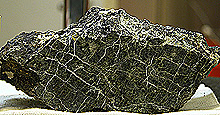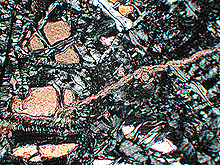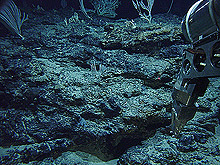Explorations | The Lost City 2005 | Background
 Serpentinites form when seawater reacts with peridotite - rocks that form the Earth's mantle and have been brought up to the seafloor by tectonic processes. This picture shows a hand sample of a serpentinite recovered from the Atlantis Massif. Thin fractures in the serpentinite are filled with calcium carbonate. Sample is 16cm wide. Click image for larger view and image credit. (HR)
Serpentinites form when seawater reacts with peridotite - rocks that form the Earth's mantle and have been brought up to the seafloor by tectonic processes. This picture shows a hand sample of a serpentinite recovered from the Atlantis Massif. Thin fractures in the serpentinite are filled with calcium carbonate. Sample is 16cm wide. Click image for larger view and image credit. (HR)The The Lost City 2005 Expedition
Gretchen Früh-GreenSenior Research Scientist
Department of Earth Sciences
ETH-Zurich, Switzerland
What Drives Hydrothermal Activity at Lost City?
The chemistry of the vent fluids and fluid circulation at Lost City are not driven by interaction of seawater with hot lava or by cooling of magma at depth. Instead hydrothermal activity at Lost City is driven by chemical reactions between seawater and mantle rocks that make up the underlying basement. This is unlike almost all other known hot spring systems on the seafloor.The mantle, or peridotite, rocks that comprise the Atlantis massif generally occur at much greater depths in the Earth - typically at depths greater than about 6 kilometers. Because of faulting these mantle rocks are now exposed at or near the seafloor and they are out of equilibrium with their surroundings. These rocks contain large amounts of the mineral olivine (a Mg-Fe silicate) which reacts with seawater at temperatures below 400°C and forms serpentine minerals (hydrous Mg-silicates) and magnetite, an iron oxide that is highly magnetic. This process, referred to as serpentinization, has major geophysical, geochemical and biological consequences for the marine system. It is a fundamental process at slow spreading ridge environments where mantle rocks are commonly exposed near the seafloor.
 This photomicrograph shows a serpentinite in a polarizing petrographic microscope. During reaction with seawater serpentine (the grey, "snake-like" minerals) forms what is called a mesh texture around olivine grains. The light colored, round minerals are relict grains of olivine. Field of view is 2.5 mm. Click image for larger view and image credit. (HR)
This photomicrograph shows a serpentinite in a polarizing petrographic microscope. During reaction with seawater serpentine (the grey, "snake-like" minerals) forms what is called a mesh texture around olivine grains. The light colored, round minerals are relict grains of olivine. Field of view is 2.5 mm. Click image for larger view and image credit. (HR) Serpentinization: The Heat Engine at Lost City and Sponge of the Oceanic Crust
An important consequence of serpentinization is the production of heat. The process of serpentinization can provide heat to drive the Lost City hydrothermal system in two ways. First, the mantle rocks underlying Lost City have residual heat from the mantle that can be "mined" through cooling with seawater. A second important source of heat is the alteration reactions themselves, which are termed exothermic because they consume water and produce a significant amount of heat during the transformation of olivine to serpentine and magnetite. The amount of heat produced is directly proportional to the amount of water that is taken up to form the mineral serpentine. In fact, serpentinization consumes an average of about 300 kilograms (approximately 300 liters or 79 US gallons) of water per cubic meter of rock that is altered. At the same time, this process produces about 660,000,000 joules of heat per cubic meter of rock.The geological significance of heat production is that serpentinization processes are capable of raising the rock temperature by about 260°C (550°F) when not including processes that lead to heat transport and cooling of the rock. It is this heat source that helps drive the Lost City hydrothermal system. This is in strong contrast to other known hydrothermal systems along the mid-ocean ridges which are driven by magmatic heat and are characterized by high temperature, metal-rich fluids that ultimately create spectacular "Black Smoker" sulfide structures.
Face Lifting through Serpentinization
Another important consequence of the formation of serpentine during hydration of mantle rocks is that the density of the rocks change from about 3.3 grams per cubic centimeter (g/cm3) to about 2.7 g/cm3 and the volume of the rocks can increase by 20-40%. Serpentinization also affects other geophysical properties of the oceanic crust by lowering the seismic velocities of the rocks, changing their gravity signatures and mechanical properties, and by increasing their degree of magnetism. The change in density and the expansion of the rocks during serpentinization has the important effect that the mountain becomes lighter and needs more room as it swells up, and thus "lifts" itself to greater elevations. The expansion of the rocks also leads to a greater number of cracks and ultimately causes mass wasting along steep slopes. This in turn creates new fractures that allow seawater to penetrate further into the mountain and react with new portions of rock that contain fresh olivine. Thus, the access of seawater to relatively cool fresh peridotite, controlled by the processes of faulting, volumetric expansion and mass wasting, is crucial to sustain Lost City-type systems.Radiogenic carbon age dating of the carbonate structures and overlying sediments indicates that the Lost City hydrothermal system has been ongoing for at least 30,000 years. This is at least two orders of magnitude longer that most of the known black smoker systems. Geophysical data also suggests that there is a significant amount of fresh peridotite at depth in the massif that can still be altered, and thus the serpentinization processes in the basement rocks have the potential to drive the Lost City system for hundreds of thousands, if not millions, of years.
 Serpentinized peridotites are the most dominant rock type recovered during past expositions on the south wall of the Atlantis Massif and form the basement of the Lost City hydrothermal vent field. This outcrop picture shows partially deformed rocks that occur at the top of the massif. The arm of the 3-person submersible Alvin is shown in the right portion of the image. Click image for larger view and image credit. (HR)
Serpentinized peridotites are the most dominant rock type recovered during past expositions on the south wall of the Atlantis Massif and form the basement of the Lost City hydrothermal vent field. This outcrop picture shows partially deformed rocks that occur at the top of the massif. The arm of the 3-person submersible Alvin is shown in the right portion of the image. Click image for larger view and image credit. (HR) Creating a long-lived, gas-rich hydrothermal environment
Because the Atlantis Massif consist mostly of peridotite and have a distinctly different composition than basalts and slower cooled counterparts (i.e. gabbros), the fluids that circulate beneath Lost City have significantly different compositions than black smoker systems. During alteration of the mantle rocks beneath Lost City, the fluids become extremely basic and reach a pH of 9 to 11. This high pH is very important because when the Lost City fluids are expelled from the chimneys, they mix with seawater and trigger chemical reactions that cause calcium carbonate (CaCO3) and brucite [Mg(OH)2] to precipitate. As long as the Lost City fluids maintain a high pH, abundant limestone will continue to be deposited and the chimneys will continue to grow.The formation of magnetite during the serpentinization process involves the oxidation of ferrous iron (Fe2+) in olivine to form ferric iron (Fe3+) in magnetite and leads to what is called reducing conditions. As a consequence, reduced gas species, such as hydrogen gas (H2), methane (CH4) and hydrogen sulfide (H2S), can be produced during serpentinization. These dissolved gas species provide important energy sources for microbial activity at Lost City. Thus, the basement rocks and the porous Lost City structures that are bathed volatile-rich, highly alkaline fluids create vital niches for life.
The gases produced at Lost City, the organisms that thrive in them and the long-lived nature of this serpentinite-driven system are very distinct from black-smoker hydrothermal vents and may represent a modern analog for some of the oldest hydrothermal systems on Earth. Thus, understanding this system may provide important new insights for studying early life on Earth as well as for looking for signs of life on other planets.

























